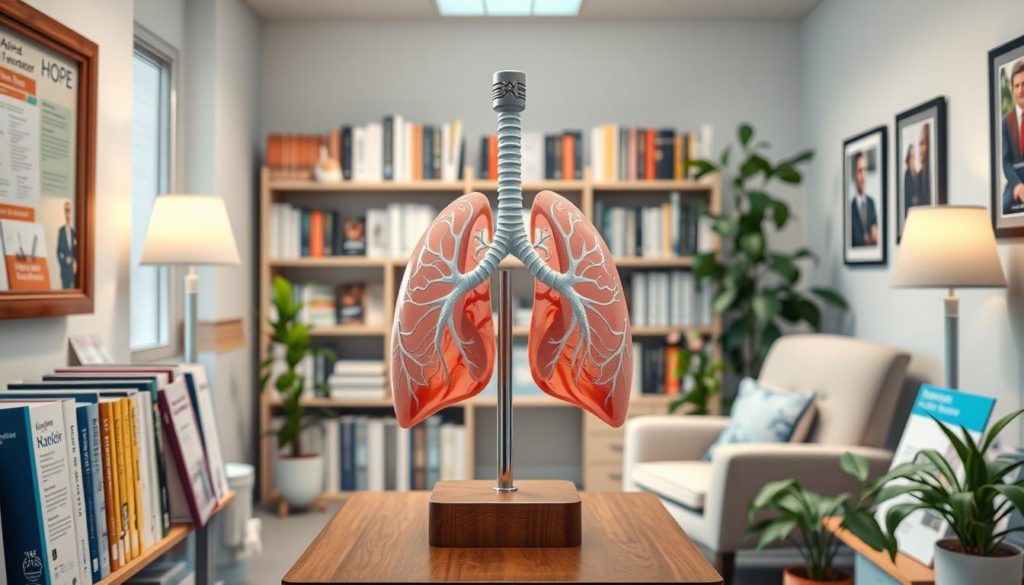Did you know about 234,030 new lung cancer cases are expected each year in the U.S.? Getting this diagnosis can feel overwhelming. Yet, knowing what to do next can help you on your journey.
After a lung cancer diagnosis, learn as much as you can about your cancer’s type and stage. This information helps you make smart choices about your care. It’s important to talk with a healthcare expert and look for reliable info.
It’s crucial to keep your health records organized. Save your diagnosis, test results, treatment plans, and doctor contacts. Keeping everything in order makes your care smoother. You can choose between digital or paper files, whatever suits you best.
Getting a second opinion can be very helpful. It lets you explore different treatment paths. It might even confirm your current plan is the best. Since some insurance requires it, know how to ask for one.
Finding the right treatment center and understanding your insurance are big steps. Consider the center’s location, how easy it is to get there, and their support services. These should meet your needs and situation.
There are many resources for lung cancer survivors. Taking care of your emotional health is as important as your physical health. Look for counseling, support groups, and talk openly with loved ones about your care needs. Staying emotionally strong is central to life post-diagnosis.
Understanding Your Lung Cancer Diagnosis
Getting a lung cancer diagnosis can feel huge, but knowing the details is key. It helps to know both the type and stage of your lung cancer. This shapes your next moves and the lung cancer treatment options you can choose from.

Types of Lung Cancer
Lung cancer comes in two main kinds: small cell lung cancer (SCLC) and non-small cell lung cancer (NSCLC). SCLC is rarer and tends to be more fierce. Meanwhile, NSCLC makes up around 85% of lung cancer cases.
Figuring out which lung cancer you have is crucial. It points you to the right treatment. If you’re wondering what to do after a lung cancer diagnosis, identifying your cancer type is step one.
Importance of Staging
The stage of lung cancer shows how far the disease has reached. Stages go from 1 to 4. Lower stages mean the cancer hasn’t spread much. Higher stages indicate it has spread. SCLC stages are called limited and extensive. Limited means it’s in one lung. Extensive shows it’s spread further.
Knowing the exact stage is crucial. It affects your outlook and treatment choices. Tools like bronchoscopies, X-rays, and scans are used for staging.
Understanding your diagnosis helps you make smart choices. It guides you on what to do after a lung cancer diagnosis and your treatment steps.
Getting a Second Opinion
Getting a second opinion is key when dealing with lung cancer. It helps patients be sure of their diagnosis. It also lets them know all their options for treatment. By understanding their situation better, patients can make informed decisions.
Why It’s Critical
A second opinion is very beneficial for lung cancer patients. It confirms the cancer’s type and how far it has spread. Then, a tailored treatment plan can be made. Patients often meet with various experts like surgeons and nurses. This team approach ensures comprehensive care, considering all options for the road ahead.

How to Ask for One
Asking for a second opinion may seem hard, but it’s important. Talk to your doctor or oncologist about wanting another opinion. Doctors usually support this choice. Make sure your insurance covers this extra consult. Taking this step can ease your mind and help you feel good about your treatment plan.
Organizing Your Health Records
Organizing health records well is key when you’re managing treatment and health insurance claims. For those diagnosed with lung cancer, it’s important to start gathering all health records. This will help you follow your treatment plan correctly.
What to Include in Your Records
Your health records should have everything from your first lung cancer diagnosis to any emotional support you’ve looked for. You need to gather several things:
- Diagnosis details
- Test results
- Treatment plans and progress
- Medication details
- Appointment dates
- Contact information for all healthcare professionals involved
- Family health history
These records are key for managing your treatment journey well.
High-Tech vs. Paper Filing
There are mainly two ways to keep your health records: digitally or with paper.
- High-Tech Filing: Keep your files digital and always back them up. This method lets you get to your records fast and keeps them safe over time. But, you need to know how to use digital tools.
- Paper Filing: Store your documents in a fireproof box. This method is easy to understand but needs space and careful organizing.
Selecting the right method is crucial for managing your treatment well. It helps in getting the support you need when battling lung cancer.
| Method | Advantages | Disadvantages |
|---|---|---|
| High-Tech Filing | Quick access, Long-term storage, Easy to share | Needs digital know-how, Risk of losing data without backups |
| Paper Filing | Physical records, No need for digital skills | Needs space, Can be damaged or lost |
Understanding Lung Cancer Treatment Options
Getting diagnosed with lung cancer is tough. But, knowing your treatment choices can give you a feeling of power and direction. The treatment depends on the cancer’s type, stage, and the patient’s health. Let’s look at some options.
Surgery
Surgery is key in early-stage lung cancer. Surgical methods vary, from removing a small lung section to taking out a whole lung. Surgery often pairs with chemo or radiation to kill off any leftover cancer cells.
Radiation Therapy
Radiation therapy targets cancer cells with high-energy rays. It can control the cancer locally, stopping it from spreading. Often, it’s used with chemo to heighten effectiveness and aid recovery from lung cancer.
Chemotherapy
Chemotherapy uses drugs to kill cancer cells. It can be given as pills, shots, or directly into the veins. Usually, it’s used after surgery to clear any remaining cancer cells. It’s vital in battling lung cancer.
Targeted Therapy
Targeted therapy zeroes in on specific cancer cell chemicals. It stops cancer growth and spread. This method works well for some lung cancers, giving many patients hope.
Immunotherapy
Immunotherapy empowers the immune system to fight cancer cells. It’s a novel approach effective against various cancers, including lung cancer. This boosts the body’s defense, aiding in lung cancer recovery.
Talking to your healthcare team about treatment options is critical. Discussing each treatment’s pros and cons helps in making an informed choice. Adding palliative care to your plan also improves life quality.
| Treatment Option | Description | Common Use |
|---|---|---|
| Surgery | Removal of cancerous lung tissue. | Early-stage lung cancer. |
| Radiation Therapy | High-energy rays to kill cancer cells. | Local control, often combined with chemotherapy. |
| Chemotherapy | Drugs that destroy cancer cells. | Post-surgery to target remaining cells. |
| Targeted Therapy | Attacks specific chemicals in cancer cells. | Specific types of lung cancer. |
| Immunotherapy | Helps the immune system recognize cancer cells. | Various stages and types of lung cancer. |
Preparing for Additional Tests
Getting diagnosed with lung cancer means you’ll need more tests. These tests are key to fully grasp your condition. They figure out the best treatment paths and offer vital support. This clarity about the cancer’s reach is crucial.
Imaging Tests
Imaging tests like X-rays and CT scans are crucial. They show where the cancer is and how big it has grown. MRI and PET scans also help. They’re important for staging the cancer right.
These tests help doctors pick the right treatments. They do this with little discomfort. And they give important details on how the cancer is spreading.
Biopsy Procedures
Biopsies confirm the cancer type. The common ways to do this include:
- Bronchoscopy: A camera-guided visual inspection that collects tissue samples.
- Mediastinoscopy: Obtains tissue samples from the lymph nodes.
- Needle Biopsies: Extracts lung tissue using a needle.
These steps are crucial for choosing treatments. They also give a better support structure for patients.
Knowing about these tests helps a lot. It affects your treatment path in big medical and emotional ways. It gets you and your family ready for what’s coming.
Choosing the Right Treatment Center
Finding the best cancer treatment center is key after a lung cancer diagnosis. It’s vital to choose wisely, ensuring it meets your needs. A good fit makes the journey smoother.
Factors to Consider
Several important factors come into play when picking a treatment center. First, ensure the center specializes in treating your type of lung cancer. Centers with a long history in lung cancer often offer the latest therapies and trials. Also, look for places with comprehensive services. Many offer patient and family support, like counseling and nutrition advice.
This holistic approach helps in managing lung cancer’s emotional toll.
Location and Accessibility
The treatment center’s location matters too. Choosing one close to home can make your visits easier. Think about how you’ll get there, like public transport or parking if you’re driving. Some centers offer accommodation or work with nearby hotels for patients from afar. Having these options can greatly ease your treatment journey.
| Consideration | Importance |
|---|---|
| Experience with Lung Cancer | High – Ensures high-quality care and advanced treatment options. |
| Support Services | Essential – Integral for managing stress after lung cancer diagnosis. |
| Location Proximity | Crucial – Reduces travel burden and stress, enhancing treatment comfort. |
| Accommodation Options | Important – Provides convenience for long-distance patients and family support. |
| Transport Accessibility | Necessary – Ensures ease of access to the treatment center. |
Managing Your Health Insurance
Understanding health insurance is key to handling your lung cancer treatment costs. Knowing your plan’s details is essential. This includes copayments, deductibles, medication costs, and your rights. It will help you plan financially for treatment.
Understanding Coverage
Start by fully reviewing your health insurance policy. It’s crucial to know what’s covered and what’s not, especially how it relates to lung cancer treatment. Lung cancer treatment is often long and expensive. Make sure to ask your insurance about specific coverages for procedures, medications, and support.
Tracking Claims and Payments
It’s important to keep a detailed record of all medical claims and payments. This helps in managing expenses and avoiding insurance problems. You could use digital tools or a notebook for tracking. Also, check out resources from lung cancer survivor groups for financial tips.
Being organized with claims and payments helps you focus on recovery. That way, you won’t get overwhelmed by the administrative side of treatment.
“Your health insurance should be a partner in your treatment journey, not another challenge to overcome.”
Also, remember to see if you qualify for government programs like Medicare and Medicaid. They can offer additional financial help if you need it.
Coping with a Lung Cancer Diagnosis
Getting diagnosed with lung cancer changes lives. It brings about many strong feelings. Patients often feel scared, angry, guilty, alone, and out of control. Knowing these feelings are normal helps start the journey to cope and find ways to handle stress.
Common Emotional Responses
Fear and anxiety are common after a lung cancer diagnosis. Patients worry about their future and treatment. They may feel angry at themselves, doctors, or family. Guilt over past decisions and feeling alone are also common. Feeling out of control makes it key to recognize and deal with these emotions.
Effective Coping Strategies
Dealing with stress from lung cancer is personal. Writing in a journal helps sort through feelings. Relaxation methods like meditation or deep breathing can bring calm. Staying connected with loved ones gives support, but some quiet time alone is okay too.
Getting help from a counselor or support groups offers relief. Talking openly with family and friends about needs and feelings helps too. This brings comfort and support.
FAQ
What are the crucial steps to take immediately after a lung cancer diagnosis?
After finding out you have lung cancer, get detailed info about your cancer type. Talk to a trusted doctor and think about getting a second opinion. Get ready for more tests to see how far the cancer has spread, and keep your health info organized.
What types of lung cancer exist, and why is staging important?
Lung cancer comes as small cell and non-small cell types. Staging shows the cancer’s spread and affects treatment plans. Early stages mean the cancer hasn’t spread much. Higher stages indicate more spread.
Is obtaining a second opinion important, and how do I request one?
Yes, a second opinion is key for peace of mind and exploring treatment options. To get one, reach out to another cancer specialist. Also, check with your insurance on their process.
What should be included in my health records post-diagnosis?
Your health records must have your diagnosis, test results, treatments, medicines, dates, and doctors’ contacts. This info is crucial.
Should I use digital files or paper for my health records?
Choose between digital files or paper records. Digital offers easy access. But, paper provides a reliable backup and should be kept safe.
What lung cancer treatment options are available?
Treatments include surgery, radiation, chemo, targeted therapy, and immunotherapy. The choice depends on cancer type, stage, and your health.
What role do surgery and radiation therapy play in lung cancer treatment?
Surgery removes tumors. It’s often followed by chemo or radiation to kill leftover cancer. Radiation targets cancer in a specific area and is paired with other treatments.
How do chemotherapy and targeted therapy differ in treating lung cancer?
Chemotherapy uses drugs to kill cancer body-wide. Targeted therapy attacks cancer’s specific genes. Both are key to overall treatment.
What additional tests might I need post-diagnosis, and why?
After diagnosis, you might need imaging tests and biopsies. They find the cancer’s exact spot, size, and spread. This info is key for planning your treatment right.
How do I choose the right cancer treatment center?
Pick a center based on its experience, location, treatment schedule, lodging, and support services. This helps in managing treatments better.
What should I understand about my health insurance when managing lung cancer treatment?
Know your insurance coverage, including copays, deductibles, and drug costs. Keep track of medical bills and check out help programs if needed.
How can I cope with the emotional impact of a lung cancer diagnosis?
Feeling scared, angry, or lonely is common. Try writing in a journal, relaxing, being social, talking to a counselor, joining support groups, and communicating with family.


